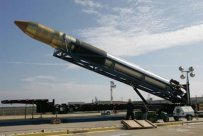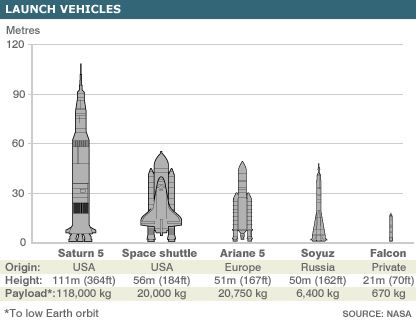Falcon 1

Falcon 1.

Falcon 1 size comparison.
The Falcon 1 is a small, two-stage rocket privately built by SpaceX (Space Exploration Technologies Corporation). Both its stages run on liquid oxygen and RP-1.
The first launch of Falcon 1, following various delays, took place on 24 March 2006 at 2230 GMT; however, the rocket was destroyed approximately one minute into its flight following an onboard fire. This was the first ground-based orbital launch from the US Army's Kwajalein base in the Marshall Islands. The inaugural payload for the Falcon 1 rocket was the US Air Force Academy's cadet-built FalconSat 2 space plasma probe. It was to have been delivered into a 250- by 310-mile orbit inclined 39° to the equator. A second, purely test launch of the Falcon 1, on 20 March 2007, also failed to reach orbit following a problem during the second stage burn. The third launch failed for a similar reason. However, the fourth flight of Falcon 1, on 28 September 2008, proved successful in placing a dummy 165-kilogram payload into orbit.
Further launches are scheduled over the next few years. Falcon 1 is the smallest of the Falcon family of launch vehicles that SpaceX proposes to build.
First stage
Falcon 1's first stage main engine, called Merlin, produces about 77,000 pounds of thrust and burns for 2 minutes 49 seconds after launch. A second after it shuts down, the separation system jettisons the parachute-equipped first stage to fall into the ocean for retrieval.
Second stage
The Kestrel second stage engine, operated by tank pressure and not a turbopump, produces about 7,000 pounds of thrust and, like the first stage, runs on refined kerosene propellant and liquid oxygen. It ignites 4 seconds after first stage separation and carries the payload into low Earth orbit. The two halves of the 5-foot diameter nose cone separate about 3 minutes 14 seconds after launch, the shroud falls away, and the payload is exposed for release into its planned orbital trajectory.
| length | 21.3 m (70 ft) |
| diameter | 1.7 m (5.5 ft) |
| mass | 27,200 kg (60,000 lb) |
| thrust on liftoff | 342 kN (77,000 lb) |


